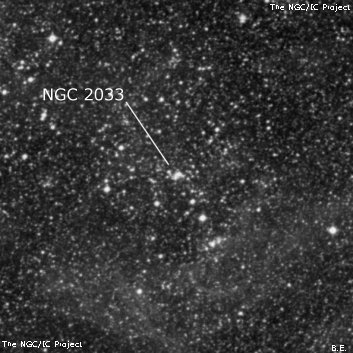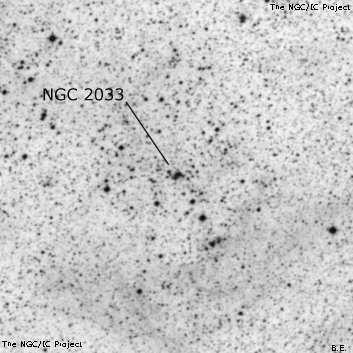NGC/IC Project Restoration Effort
(This is a very very beta version)
NGC2033


Basic Information
Location and Magnitude
Right Ascension: 5:34:30.6
Declination: -69:46:48
Constellation: DOR
Visual Magnitude: 11.6
Historic Information
Discoverer: Herschel J.
Year of discovery: 1835
Discovery aperture: 18.3
Observational
Summary description: Cl, in Nubec major
Sub-type: OCL
Corwin's Notes
=====
NGC 2033 and NGC 2037. These are two successive objects found by JH, and
called clusters by him, in one of his "zones" that he swept across the LMC
between November 1836 and March 1837 with a 5-inch refractor. Judging by the
positions of stars in these zone sweeps, JH's places are about as good as
those determined with the sweeps with the 20-foot reflector. So, we would
expect to find "clusters" within a couple of arcminutes of JH's positions.
Here are his data (positions for 1830, NPD):
No. Type Mag. RA NPD Zone
579 Cl 11 05 36 02 159 53 33 20 = NGC 2033
593 C [sic] 8 05 36 35 159 52 33 20 = NGC 2037
Yet there is not much to catch the eye in either place. Most modern observers
(cf. Hodge and Wright, Archinal and Hynes, Morel, and Kay) take the star cloud
north of JH's position for NGC 2033, and assign NGC 2037 to the compact
cluster at 05 35 06.6, -69 46 37 (B1950), but not Hodge and Wright -- they
choose the eastern part of the NGC 2033 star cloud.
Having fussed over this field for several hours early in January 2014, I'm
comfortable now with that identification of NGC 2033, but not with NGC 2037.
I do not see how JH could have seen this faint, small cluster with a 5-inch,
let alone call it magnitude 8. Jenni Kay estimates its magnitude as 12, and
its size as just 18 arcseconds.
So, I suspect some error in JH's position for these objects. Looking at the
field on the DSSR2 image, reasonable objects, based on the Hodge-Wright Atlas,
might be these (again, positions for 1830, NPD):
NGC 2033 05 36 07 159 52.0 8' x 5'
NGC 2037 05 36 31 159 50.5 3' x 1.5'
This pushes the positions north by about two arcmin, but necessitates a
switch of JH's magnitudes.
Another option:
NGC 2033 05 36 10 159 51.6 10' x 8'
NGC 2037 05 36 59 159 48.5 4' x 3'
I checked for digit errors, but found nothing to the north or the west --
these two objects are near the southeastern corner of zone 20.
So, what did JH actually see? We may never know.
Finally, as a footnote to this short discussion touching on the 5-inch sweeps,
I can't help but add a note from JH's text in CGH:
It was not considered necessary to go over the work twice. Independent of
the value of time under all circumstances, *the sweeping position, at
considerable altitudes, with any instrument but a reflector is so
excessively painful (and indeed so permanently injurious to the muscles of
the back and neck), that it is scarcely endurable beyond an hour at a time*
[JH's italics], for which reason alone I felt little inclination to repeat
it.
Is it possible that the strain JH put himself through contributed to this
particular puzzle? From my own extensive observing at the Cassegrain focus of
McDonald Observatory's 76-cm reflector, I can attest to the changes --
sometimes radical -- brought on in my vision by back and neck strain. That
can be very unpleasant indeed.
Steve's Notes
=====
NGC 2033
14" (4/4/16 - Coonabarabran, 142x and 230x): large bright star cloud (stellar association LH 81), ~10' diameter with ~50 stars (depending on size taken) mag 11-14. Adding an NPB filter brings out the associated nebulosity (LHA 120-N54), which is fairly bright and very large. A curving swath of nebulosity, elongated E-W for ~8' on the southwest side of the association. The cluster itself is also encased in diffuse nebulosity with the filter. NGC 2037 is generally taken as a small knot (BCDSP 8) within this star cloud. NGC 2048, a bright emission nebula, is at the northeast end of the association.



